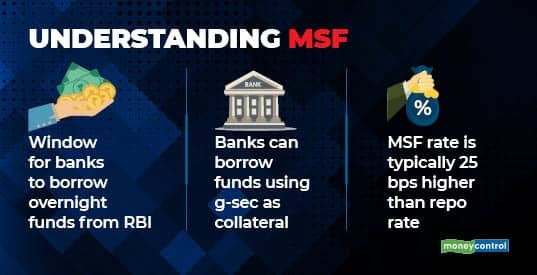Demystifying the Marginal Standing Facility: A Lifeline for Banks in Tight Times
The Marginal Standing Facility (MSF) serves as a crucial safety net for banks in the financial system. Operating as a window of opportunity, it allows scheduled commercial banks to borrow overnight funds from the central bank, typically at a higher rate than the repo rate.
Understanding the Need for MSF:
Banks play a pivotal role in the economy by facilitating lending and credit creation. However, situations arise where banks face temporary liquidity shortages due to various factors like unexpected withdrawals, seasonal fluctuations, or market disruptions. In such scenarios, the MSF acts as a lifeline, providing access to emergency funds to maintain their liquidity and prevent financial instability.
 |
| Demystifying the Marginal Standing Facility |
How Does MSF Function?
- Eligibility: Scheduled commercial banks maintaining the minimum Statutory Liquidity Ratio (SLR) are eligible to utilize MSF.
- Mechanics: Banks can borrow funds against approved government securities, such as treasury bills and bonds.
- Interest Rate: The MSF rate is generally set higher than the repo rate to act as a disincentive for excessive borrowing and discourage routine reliance on the facility.
- Term: The facility offers overnight loans, ensuring short-term liquidity support.
Benefits of MSF:
- Financial Stability: By providing emergency funds, MSF helps maintain financial stability by preventing liquidity crises that could have broader economic repercussions.
- Market Confidence: The availability of MSF instills confidence in the financial system, reassuring investors and depositors of the banking system's resilience.
- Monetary Policy Transmission: MSF helps ensure effective transmission of monetary policy by providing a ceiling for overnight lending rates.
- Flexibility: The overnight nature of the facility allows banks to quickly access funds and manage their liquidity needs efficiently.
Limitations of MSF:
- Moral Hazard: Overreliance on MSF can lead to complacency and weaken banks' risk management practices.
- Inflationary Pressures: Excessive borrowing at the higher MSF rate can inject additional liquidity into the system, potentially contributing to inflationary pressures.
- Limited Scope: MSF addresses short-term liquidity needs and is not a solution for chronic structural problems within the banking system.
Recent Developments in India:
- Introduction in 2011: The RBI introduced MSF in India in 2011 to replace the earlier overnight indexed swap (OIS) facility.
- Rate Changes: The MSF rate has been adjusted several times in response to changing economic conditions.
- Increase in Usage: During periods of demonetization and financial stress, banks have increased their reliance on MSF.
Looking Ahead:
The MSF will continue to play a critical role in the Indian financial system. The RBI will likely continue to refine and adapt the facility to ensure its effectiveness in managing liquidity and fostering financial stability in the evolving economic landscape.
In conclusion, the Marginal Standing Facility serves as a vital safety net for banks in the financial system. By offering emergency liquidity support, it helps maintain financial stability, market confidence, and effective monetary policy transmission. While challenges remain regarding moral hazard and inflationary pressures, the MSF will continue to be an indispensable tool for the central bank in ensuring a robust and resilient financial system.
